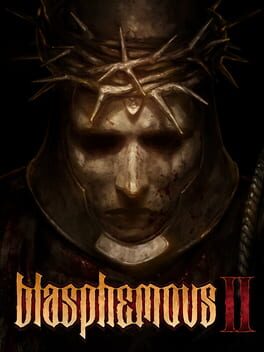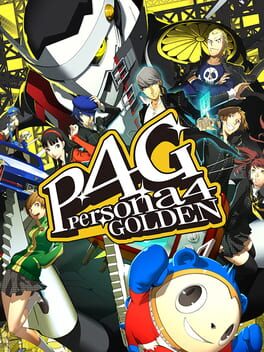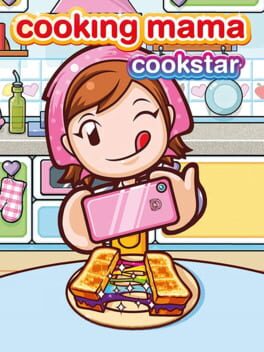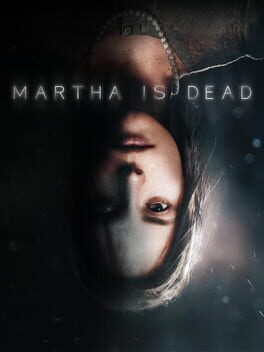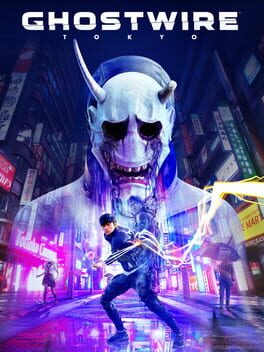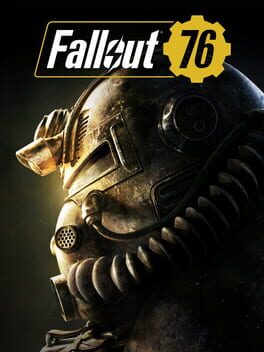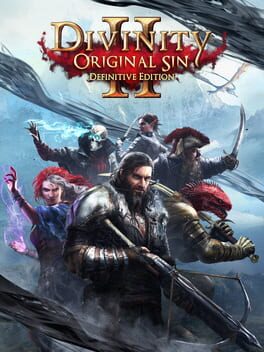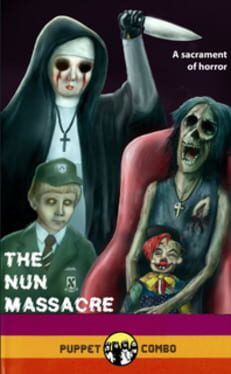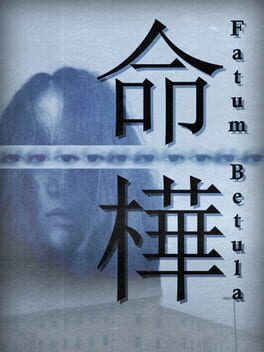Gameovah
2023
5.5/10
As a metroidvania is a little more dynamic and refined than the first one. The music is still brilliant.
Except for some sprites and animations, the visuals instead have worsened a lot. Most enemies are more fantasy and mythologic, colorful, and the new pixel art doesn't help making them brutal as those in the first game. Boss design is less obscure as well - some bosses, like Radames, seem to come from some generic dark fantasy anime. Same goes for the cutscenes: those of the first one were small masterpieces, here the artworks clash with the overall atmosphere and aesthetic and make it more cartoonish and pleasing.
The lore is still good but less original and coherent than before. You have martyrs, penitents, and tortures but there are also more generic places and subplots here and there - the Lovecraftian dungeon, the Victorianish urban landscape, the haunted mansion...
It may be a better metroidvania than before but it's way less interesting as both a historical and a theological game.
As a metroidvania is a little more dynamic and refined than the first one. The music is still brilliant.
Except for some sprites and animations, the visuals instead have worsened a lot. Most enemies are more fantasy and mythologic, colorful, and the new pixel art doesn't help making them brutal as those in the first game. Boss design is less obscure as well - some bosses, like Radames, seem to come from some generic dark fantasy anime. Same goes for the cutscenes: those of the first one were small masterpieces, here the artworks clash with the overall atmosphere and aesthetic and make it more cartoonish and pleasing.
The lore is still good but less original and coherent than before. You have martyrs, penitents, and tortures but there are also more generic places and subplots here and there - the Lovecraftian dungeon, the Victorianish urban landscape, the haunted mansion...
It may be a better metroidvania than before but it's way less interesting as both a historical and a theological game.
2023
5/10
Cute, hyper-repetitive fishing game. The gameplay loop is pretty addictive, easy-to-get-into, and funny.
Aesthetics, plot, worldbuilding, and atmosphere reinterpret Lovecraft without taste: the cute visuals, the chilling atmospheres, and the inert mechanics in any way manage to refashion cosmic horror, which instead here is just flattened. One of the worst examples of commodification of the source material, in that sense.
If you like boats and Lovecraft, play Sunless Sea instead.
Cute, hyper-repetitive fishing game. The gameplay loop is pretty addictive, easy-to-get-into, and funny.
Aesthetics, plot, worldbuilding, and atmosphere reinterpret Lovecraft without taste: the cute visuals, the chilling atmospheres, and the inert mechanics in any way manage to refashion cosmic horror, which instead here is just flattened. One of the worst examples of commodification of the source material, in that sense.
If you like boats and Lovecraft, play Sunless Sea instead.
4/10
Overlong, uselessly redundant, extremely convoluted. It mixes hundreds (literally: hundreds) of sci-fi clichés, it explores 13 different plots and respective characters, all intertwined. Multiple realities, different timelines, ai, cyborgs, mecha, aliens, seriously this is one of the most chaotically unbearable narrative worlds I've ever been exposed to.
Gameplaywise, it's both a visual novel and a turn-based strategy game. The former provides you with the chunks of story and information you're missing in real time, and therefore transforms dialogues and exploration in too-often machinic procedures, in which you just try different choices over and over again just to see what happens (and you spend more time staring at diagrams and game menus than being immersed in the story). The latter is so aesthetically uninteresting, so slow, and so dramatically repetitive that you cannot but miss being forced to go over the same dialogues over and over again instead of fighting kaijus - which is, on paper, just unbelievable.
The art style is its best feature. But despite things have improved since other Vanillaware games, the artworks are still so oversexualised you just cannot take them seriously. Even allegedly dramatic scenes become tragicly funny.
Inadmissible.
Overlong, uselessly redundant, extremely convoluted. It mixes hundreds (literally: hundreds) of sci-fi clichés, it explores 13 different plots and respective characters, all intertwined. Multiple realities, different timelines, ai, cyborgs, mecha, aliens, seriously this is one of the most chaotically unbearable narrative worlds I've ever been exposed to.
Gameplaywise, it's both a visual novel and a turn-based strategy game. The former provides you with the chunks of story and information you're missing in real time, and therefore transforms dialogues and exploration in too-often machinic procedures, in which you just try different choices over and over again just to see what happens (and you spend more time staring at diagrams and game menus than being immersed in the story). The latter is so aesthetically uninteresting, so slow, and so dramatically repetitive that you cannot but miss being forced to go over the same dialogues over and over again instead of fighting kaijus - which is, on paper, just unbelievable.
The art style is its best feature. But despite things have improved since other Vanillaware games, the artworks are still so oversexualised you just cannot take them seriously. Even allegedly dramatic scenes become tragicly funny.
Inadmissible.
6/10
As the nth posthuman narrative on how humans destroyed the world and themselves, the game works pretty well. It is short and straightforward, it doesn't want to be funny, and it has some very moving moments.
The only thing that I lacked was becoming an actual caregiver of my children - they cannot be hurt, they don't have to hide, they are basically like Ellie in The Last of Us. Soon, you start running around as if alone, and since the game is all about caregiving this is kinda bad.
Although didactic, the storytelling is pretty good and doesn't fall into simplistic cliches as many others. The double ending could be avoided but it's not that big of a deal.
If you love foxes, hate human beings, want to cry over your sins, and imagine absolution in a future extinction, then this is the game for you.
As the nth posthuman narrative on how humans destroyed the world and themselves, the game works pretty well. It is short and straightforward, it doesn't want to be funny, and it has some very moving moments.
The only thing that I lacked was becoming an actual caregiver of my children - they cannot be hurt, they don't have to hide, they are basically like Ellie in The Last of Us. Soon, you start running around as if alone, and since the game is all about caregiving this is kinda bad.
Although didactic, the storytelling is pretty good and doesn't fall into simplistic cliches as many others. The double ending could be avoided but it's not that big of a deal.
If you love foxes, hate human beings, want to cry over your sins, and imagine absolution in a future extinction, then this is the game for you.
2012
This review contains spoilers
6.5/10
Ok, this game has issues, especially concerning ideological biases and hegemonic representations.
To name the most evident one, it’s undoubtedly the most explicit homo/transphobic game I’ve ever played: whole homophobic dungeon and narrative arch, major homophobic gags and dialogues, and a notable character development revolving around being afraid to be homosexual. It depicts a community that perceives homosexuality as something weird and horrific and it keeps claiming this throughout all its duration, until the very end (the last time Kanji’s homosexuality is implied is in one of the extra cutscenes from the extra last dungeon arch in February). Naoto’s development is perhaps even more scary. Due to her androgyny, Naoto is constantly sexualised and objectified; she can find herself only by refusing her male persona; and her romance route implies her rejecting her own masculinity, speaking with sharper voice, and dressing as a female.
These ideological assumptions are also backed by how the game ultimately depicts personal growth and human existence. In Persona 4, people grow up and find themselves only by accepting the world and their role within it as they are. Every character is initially depicted as refusing the ‘facticity’ of her existence. Eventually, everyone increasingly accepts the role society provided them, even embrace it. Rise returns to be an idol; Yukiko accepts her role at the Amagi Inn; Yosuke embraces his life at Inaba; and so on. Whilst Persona 5 depicts characters as dramatically refusing the world they inhabit as it is, Persona 4 conceives their becoming adults as fundamentally reconciling with reality after having challenged it. Although this may be existentially questioned, it makes sense. It just becomes dumb when the game assumes that “reality” is being a female if you are born in a female body; or liking girls if you are born male – and therefore contends that to find your place in the world you must reconcile with the role that heteronormative masculinity gave you: gays must be hetero; masculine females must turn feminine; idols must remain idols. The desire to escape reality is, in other words, demonic – and must be overcome… or defeated.
The best aspect of the game (as in Persona 5) is its psycho-philosophical lore and worldbuilding. Here the heroes face a TV world that’s raised by the collective unconscious; they face their inner fears and projected personas; they find out that their role in the world is not something they create but that others project onto them (but then eventually embrace it :/); they defeat a deity that’s embodiment of the above-mentioned collective unconscious and desire to escape reality. Brilliant! Perhaps less effective than Persona 5, and a little more rushed towards its ending (right after finding out who the killer is: hey, I’m an evil god, face me!) but brilliant nonetheless – you literally fight against a re-imagined version of yourself you are afraid of, you accept it, you solve a mysterious crime, and you end up fighting a multicoloured Big Brother, I mean, what more do you want?
Other than that, the game has all the good and bad things Persona games usually feature: its quintessential power fantasy and player empowering clash with the life simulator mechanics (everyone, literally everyone loves you, you are the best human being Inaba and the world has a whole could dream of, et cetera), its dungeons are repetitive and dumb but the overall experience is so emotional, cosy, and imbued with feelings that you cannot but enjoy it. Its length and repetitive structure make you inhabit Inaba, actively build those friendships, creating memories across those places and routines. Its carachters and stories are also much more plausible than those of Persona 5, more credible, and this makes the Social Links much more enjoyable. Eventually, regardless of all its issues, you cannot but miss this world.
The branching of endings is also much more complex than in Persona 5 and to a degree asks you to solve the case yourself, which is good. The game endlessly delays its own ending and grants you more and more time to spend in Inaba. It may be overlong and boring but it’s also loveable.
Favourite character: Kanji.
Favourite crush: Naoto.
Least favourite character: Protagonist.
Favourite dungeon: Hollow Forest
Ok, this game has issues, especially concerning ideological biases and hegemonic representations.
To name the most evident one, it’s undoubtedly the most explicit homo/transphobic game I’ve ever played: whole homophobic dungeon and narrative arch, major homophobic gags and dialogues, and a notable character development revolving around being afraid to be homosexual. It depicts a community that perceives homosexuality as something weird and horrific and it keeps claiming this throughout all its duration, until the very end (the last time Kanji’s homosexuality is implied is in one of the extra cutscenes from the extra last dungeon arch in February). Naoto’s development is perhaps even more scary. Due to her androgyny, Naoto is constantly sexualised and objectified; she can find herself only by refusing her male persona; and her romance route implies her rejecting her own masculinity, speaking with sharper voice, and dressing as a female.
These ideological assumptions are also backed by how the game ultimately depicts personal growth and human existence. In Persona 4, people grow up and find themselves only by accepting the world and their role within it as they are. Every character is initially depicted as refusing the ‘facticity’ of her existence. Eventually, everyone increasingly accepts the role society provided them, even embrace it. Rise returns to be an idol; Yukiko accepts her role at the Amagi Inn; Yosuke embraces his life at Inaba; and so on. Whilst Persona 5 depicts characters as dramatically refusing the world they inhabit as it is, Persona 4 conceives their becoming adults as fundamentally reconciling with reality after having challenged it. Although this may be existentially questioned, it makes sense. It just becomes dumb when the game assumes that “reality” is being a female if you are born in a female body; or liking girls if you are born male – and therefore contends that to find your place in the world you must reconcile with the role that heteronormative masculinity gave you: gays must be hetero; masculine females must turn feminine; idols must remain idols. The desire to escape reality is, in other words, demonic – and must be overcome… or defeated.
The best aspect of the game (as in Persona 5) is its psycho-philosophical lore and worldbuilding. Here the heroes face a TV world that’s raised by the collective unconscious; they face their inner fears and projected personas; they find out that their role in the world is not something they create but that others project onto them (but then eventually embrace it :/); they defeat a deity that’s embodiment of the above-mentioned collective unconscious and desire to escape reality. Brilliant! Perhaps less effective than Persona 5, and a little more rushed towards its ending (right after finding out who the killer is: hey, I’m an evil god, face me!) but brilliant nonetheless – you literally fight against a re-imagined version of yourself you are afraid of, you accept it, you solve a mysterious crime, and you end up fighting a multicoloured Big Brother, I mean, what more do you want?
Other than that, the game has all the good and bad things Persona games usually feature: its quintessential power fantasy and player empowering clash with the life simulator mechanics (everyone, literally everyone loves you, you are the best human being Inaba and the world has a whole could dream of, et cetera), its dungeons are repetitive and dumb but the overall experience is so emotional, cosy, and imbued with feelings that you cannot but enjoy it. Its length and repetitive structure make you inhabit Inaba, actively build those friendships, creating memories across those places and routines. Its carachters and stories are also much more plausible than those of Persona 5, more credible, and this makes the Social Links much more enjoyable. Eventually, regardless of all its issues, you cannot but miss this world.
The branching of endings is also much more complex than in Persona 5 and to a degree asks you to solve the case yourself, which is good. The game endlessly delays its own ending and grants you more and more time to spend in Inaba. It may be overlong and boring but it’s also loveable.
Favourite character: Kanji.
Favourite crush: Naoto.
Least favourite character: Protagonist.
Favourite dungeon: Hollow Forest
2022
7/10
It's one of the best "historical games" I've ever played. At times it's kinda naive in its storytelling, and perhaps it's too ambitious towards its ending but undoubtedly it has design and narrative intuitions that are so great, intelligent, and moving that I couldn't but enjoy it.
The game revolves around identity, (historical) agency, and remembering. The loss of self is associated with a loss of memory, and the game as a whole deals with remembering something that is usually forgotten in current history and historical games, i.e., marginalised individuals, frailty, mental ilness, and so on. The game is about war but it's not a war game: it's about a girl, someone that history usually forgets. All we do as we play is striving to remember: we mostly take photos, develop them, read things, re-enact overlong technological practices that are now long gone. Remembering is both diegetic and extra-diegetic: Giulia strives to remember and playing itself is an act of remembering.
The puppets make this convergence of theme, narrative, and gameplay even more explicit: playing with them is an analogon of playing the game, in both we uncover terrible forgotten truths. And both are dramatically linear, hauntingly suspended between reality and fiction, and pre-determined by someone (the designer or Giulia herself, both are puppet masters within their respective textual framework).
The greatest thing is that playing with these puppets is the only way to remember what actually (?) happened. In a similar guise, we play with the game to remember someone who's usually forgotten, a puppet of history among others, whose agency was denied.
Censored content is something you shouldn't miss: please play uncensored versions of the game.
[Podcast incoming for all the Italian speakers interested ;)]
It's one of the best "historical games" I've ever played. At times it's kinda naive in its storytelling, and perhaps it's too ambitious towards its ending but undoubtedly it has design and narrative intuitions that are so great, intelligent, and moving that I couldn't but enjoy it.
The game revolves around identity, (historical) agency, and remembering. The loss of self is associated with a loss of memory, and the game as a whole deals with remembering something that is usually forgotten in current history and historical games, i.e., marginalised individuals, frailty, mental ilness, and so on. The game is about war but it's not a war game: it's about a girl, someone that history usually forgets. All we do as we play is striving to remember: we mostly take photos, develop them, read things, re-enact overlong technological practices that are now long gone. Remembering is both diegetic and extra-diegetic: Giulia strives to remember and playing itself is an act of remembering.
The puppets make this convergence of theme, narrative, and gameplay even more explicit: playing with them is an analogon of playing the game, in both we uncover terrible forgotten truths. And both are dramatically linear, hauntingly suspended between reality and fiction, and pre-determined by someone (the designer or Giulia herself, both are puppet masters within their respective textual framework).
The greatest thing is that playing with these puppets is the only way to remember what actually (?) happened. In a similar guise, we play with the game to remember someone who's usually forgotten, a puppet of history among others, whose agency was denied.
Censored content is something you shouldn't miss: please play uncensored versions of the game.
[Podcast incoming for all the Italian speakers interested ;)]
2022
6/10
It's a great example of game tourism and commodification of tradition, cultural heritage, and identity. Exploring a haunted Tokyo, inhabited by ghosts and manifestations of sociocultural, economic, and political anxieties and discontents is great, even if it becomes repetitive and machinic quite soon (structure-wise, the game is a hyper-classic and hyper-toxic open world after all... but hey, isn't this the point of commodifying stuff after all?).
Of course the game works as a horrorish theme park, less as a horror satire. And even lesser as an action/adventure with over-the-top commentary and supernatural themes. In the end, the narrative aspects of the game are those that just don't work. The gameplay isn't great either... but at least it's not bad as the plot.
What's genuinely great about the game is how it uses glitch aesthetics to show the vulnerability of the phenomenic world depicted. Perceptual reality is unstable and fragile, it's systematically haunted by entities that come from somewhere beyond perception. And so the digital stability of the game is increasingly questioned: glitches, pixels, bugs, disappearing and reappearing objects, signage and 2D writings that come to life... It's a classic action game but in which the ontological stability of what's depicted is questioned for thematic purposes. Which is surprisingly good.
It's a great example of game tourism and commodification of tradition, cultural heritage, and identity. Exploring a haunted Tokyo, inhabited by ghosts and manifestations of sociocultural, economic, and political anxieties and discontents is great, even if it becomes repetitive and machinic quite soon (structure-wise, the game is a hyper-classic and hyper-toxic open world after all... but hey, isn't this the point of commodifying stuff after all?).
Of course the game works as a horrorish theme park, less as a horror satire. And even lesser as an action/adventure with over-the-top commentary and supernatural themes. In the end, the narrative aspects of the game are those that just don't work. The gameplay isn't great either... but at least it's not bad as the plot.
What's genuinely great about the game is how it uses glitch aesthetics to show the vulnerability of the phenomenic world depicted. Perceptual reality is unstable and fragile, it's systematically haunted by entities that come from somewhere beyond perception. And so the digital stability of the game is increasingly questioned: glitches, pixels, bugs, disappearing and reappearing objects, signage and 2D writings that come to life... It's a classic action game but in which the ontological stability of what's depicted is questioned for thematic purposes. Which is surprisingly good.
2018
5/10
It's a good digitalisation of a pen and paper rpg, assuming that such a thing makes sense. Its hyper-traditional aesthetics, its uninteresting plot and worldbuilding, its emphasis on fun and potentially hilarious situations, its stereotypical cast and very basic questlines, by the way, make me hard to enjoy it.
Fun and good mechanics are usually not what I look for in (both pen&paper and digital) rpgs: I look for immersion, narrative involvement, intruiguing worldbuilding, good casts and original approaches to cliches and fantasy tropes. Not for an open-ended and hyper comples tabletop game.
It's a good digitalisation of a pen and paper rpg, assuming that such a thing makes sense. Its hyper-traditional aesthetics, its uninteresting plot and worldbuilding, its emphasis on fun and potentially hilarious situations, its stereotypical cast and very basic questlines, by the way, make me hard to enjoy it.
Fun and good mechanics are usually not what I look for in (both pen&paper and digital) rpgs: I look for immersion, narrative involvement, intruiguing worldbuilding, good casts and original approaches to cliches and fantasy tropes. Not for an open-ended and hyper comples tabletop game.
2023
5/10
It is undoubtedly the most refined Final Fantasy since the twelfth installment in the series.
And yet, compared to Final Fantasy XV, this is not necessarily a good thing (unless you want to claim that something stable, balanced, refined, and polished is by definition better than something unstable, unbalanced, unpolished, and unrefined - which is something I strongly disagree with). FFXV was incomplete, hasty, and narratively defective but how original was its touristic reinterpretation of the hero's journey?, how fresh and cruel was its approach to the Bildungsroman?, how brilliant was its use of open world mechanics and ludonarrative dissonance to make you actively delay the moment you'd face your destiny?, how brilliant was its rhetoric use of its worldbuilding and aesthetics?, how brave was its merging high fantasy, magitek, and japanese trashy clichés?
Compared to that, FFXVI is rather serious and straightforward. Spoilers ahead - The plot is archetypal: first you must free people from slavery and then you must save the world from being enslaved by a god in a (guess what?) neverending cycle of death and rebirth. A quest for the free will then, socio-political first and philosophical then, in both cases markedly existential. It's something that Final Fantasy fans are (perhaps too much) familiar with, as this could be the synopsis of most of the games in the series. This time, the worldbuilding is much more pluralistic than usual, inspired by Game of Thrones but without relativism. The Dominants remind of Attack on Titan's giants and the Eikons are destructive death-bringers depicted as kaijus (Ifrit appears just like Godzilla) - in the end, the quest to free mankind from slavery is also a quest to free the world from such powerful weapons (and this trough the use of such weapons, of course). A quest to destroy technologies of power, that begins with a wise use of those same technologies.
The gameplay is rather dull: you basically walk (or run) and kill things from beginning to end. Primary quests are terribly linear but full of good cutscenes and breathtaking action sequences, which is good. Secondary ones are all fetch quests: speak here, speak there, speak back here, kill that monster, speak again, that's it. Except for a bunch of quests towards the end of the game, all the non-primary material here is (both gameplay and plotwise) almost pure trash.
Which is not that surprising, I mean, the whole series is about having a story-driven main quest and dozens of dissonant (at best) or dramatically bad (at worst) secondary activities - with the only exception being FFXV, which as said tried to make sense of its dissonance.
Let's just say that they could be more daring this time. Although there's violence and sexuality in an unprecedented way for the series, the rest is rather conservative, from the narrative tropes to the mmorpg gameplay.
The plot may be rich and all but I personally fond it less exciting (and moving, and thought provoking) than most of the others in the series, and same goes for the rich, perhaps too rich, cast of characters.
It is undoubtedly the most refined Final Fantasy since the twelfth installment in the series.
And yet, compared to Final Fantasy XV, this is not necessarily a good thing (unless you want to claim that something stable, balanced, refined, and polished is by definition better than something unstable, unbalanced, unpolished, and unrefined - which is something I strongly disagree with). FFXV was incomplete, hasty, and narratively defective but how original was its touristic reinterpretation of the hero's journey?, how fresh and cruel was its approach to the Bildungsroman?, how brilliant was its use of open world mechanics and ludonarrative dissonance to make you actively delay the moment you'd face your destiny?, how brilliant was its rhetoric use of its worldbuilding and aesthetics?, how brave was its merging high fantasy, magitek, and japanese trashy clichés?
Compared to that, FFXVI is rather serious and straightforward. Spoilers ahead - The plot is archetypal: first you must free people from slavery and then you must save the world from being enslaved by a god in a (guess what?) neverending cycle of death and rebirth. A quest for the free will then, socio-political first and philosophical then, in both cases markedly existential. It's something that Final Fantasy fans are (perhaps too much) familiar with, as this could be the synopsis of most of the games in the series. This time, the worldbuilding is much more pluralistic than usual, inspired by Game of Thrones but without relativism. The Dominants remind of Attack on Titan's giants and the Eikons are destructive death-bringers depicted as kaijus (Ifrit appears just like Godzilla) - in the end, the quest to free mankind from slavery is also a quest to free the world from such powerful weapons (and this trough the use of such weapons, of course). A quest to destroy technologies of power, that begins with a wise use of those same technologies.
The gameplay is rather dull: you basically walk (or run) and kill things from beginning to end. Primary quests are terribly linear but full of good cutscenes and breathtaking action sequences, which is good. Secondary ones are all fetch quests: speak here, speak there, speak back here, kill that monster, speak again, that's it. Except for a bunch of quests towards the end of the game, all the non-primary material here is (both gameplay and plotwise) almost pure trash.
Which is not that surprising, I mean, the whole series is about having a story-driven main quest and dozens of dissonant (at best) or dramatically bad (at worst) secondary activities - with the only exception being FFXV, which as said tried to make sense of its dissonance.
Let's just say that they could be more daring this time. Although there's violence and sexuality in an unprecedented way for the series, the rest is rather conservative, from the narrative tropes to the mmorpg gameplay.
The plot may be rich and all but I personally fond it less exciting (and moving, and thought provoking) than most of the others in the series, and same goes for the rich, perhaps too rich, cast of characters.
2018
2018
2020

